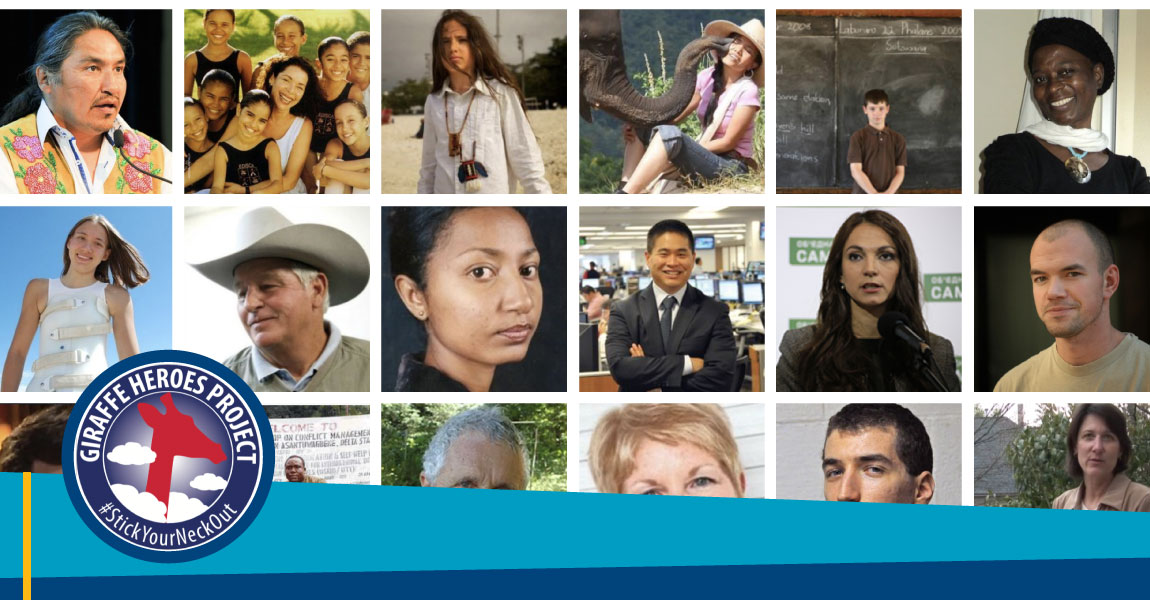The Giraffe Heroes Project moves people to brave, compassionate action for the common good—and at no time has that been more important than during the 2020 coronavirus (COVID-19) pandemic.
The Project finds “Giraffe Heroes” — compassionate risk-takers who are largely unknown, people who have the courage to stick their necks out for the common good—like today’s health care providers and other essential workers. When the Project tells the stories of these remarkable people through traditional and social media, others see and hear these stories and are inspired to help solve the problems of most concern to them, from diseases and corruption to poor leadership and crimes against women. The Project’s books, blogs, curricula, speeches, and trainings give activists and would-be activists the tools they need to succeed.
Telling the stories of heroes may be the oldest strategy in the world for motivating people into brave and caring service—and it works. As long as there are Giraffe Heroes, there’s hope. And citizens respond: “I was so moved by the Project’s story of (epidemiologist) Dr. Chu. Speaking truth to power is the only way we are going to get out of this darkness. May we all be a light and lead the way for others. Thank you for yours.” —Mary Ann Mansfield. To see the stories of more heroes like Dr. Chu, go to www.giraffe.org/pandemic-heroes-resources.
Featured Guest:
John Graham, Director
Giraffe Heroes Project
Approach to Collaboration
The Project collaborates with other organizations and with individuals in a variety of ways. We work with the public to send us nominations of the heroes they see, and, for the coronavirus pandemic, we’ve created a downloadable “Thank You” people can pass on to those heroes. We collaborate with social media outlets to help us tell the inspiring stories of heroes. Because publicity is protection, our storytelling helps protect “whistleblowing” heroes whose lives and safety may be in danger from those who would like them to stay quiet.
Our overseas operation, Giraffe Heroes International (GHI), now has affiliates in nine countries, with whom we collaborate to find local heroes and tell their inspiring stories. For example, Giraffe Heroes Zimbabwe now has over eighty people on the ground, pushing for a government that can finally provide the peace and justice that the country deserves. Dr. Sushil Koirala, the GHI Director in Nepal, has become a trusted national figure guiding his nation’s fight against COVID-19. We collaborate with NGOs all over the world to help us magnify the voices and impacts of the Giraffe Heroes whose stories we tell.
For 30 years, we’ve been developing programs in service-learning, civic engagement, and character development. Right now, we are collaborating with teachers and parents to use our materials to get their locked-down youngsters thinking about the courageous, compassionate heroes of our world, and to come up with ways they can exercise their own innate compassion. The first educators to see our pandemic lessons told us they were “brilliant” and would be welcomed eagerly by teachers everywhere.
We write books, give lectures, provide coaching, and other important tools to citizens of all ages who want to make a difference. We partner with educational and social organizations to advance the knowledge of civic engagement and to collaboratively share what we know. We collaborate with podcasts worldwide. Our partners are our megaphones, and they bring our words to much bigger audiences.
As technology advances, we need to advance as well. When we began telling our Giraffe stories, we started with faxes and vinyl records. Now, our reach is far greater, utilizing our website and a variety of social media channels. Social media also dramatically increases our opportunities to collaborate with other like-minded organizations. We are consistently striving for innovative online collaborations that help inspire others to stick their necks out, tackling public problems in their neighborhood, community, or the world.
Application of the 9 Considerations for Collaboration
Build Trust
We build trust with our audiences, with Giraffe Heroes, and with like-minded organizations and other collaborators, by being competent, honest, professional communicators, and by always following through on our commitments and responsibilities. Nothing significant can happen without first building trust.
Have a Vision
The Giraffe Heroes Project knows that good ideas and good ideals are not enough by themselves to ensure success. Having a strong vision is imperative. The Project is continually advancing its vision of moving more and more people to stick their necks out for the common good — turning their ideas and ideals for a better world into action.
Part of our vision for the future is to support our print and online stories of heroes with short, compelling videos. As attention spans shorten, we recognize that people will be spending less and less time looking at written words. And so, in 2020, we are using a small grant to begin creating short one-minute videos that can be easily shared on phones and tablets, especially by young people.
Seek to Assure the Success of Your Collaborators
Other nonprofits also seek to motivate citizens into civic action, especially in the field of K-12 education, and as we all struggle to be of maximum use during this pandemic. We see such organizations as collaborators rather than competitors, and we maintain honest, friendly, and helpful relationships with them. We join them at panels and national conferences. We share our experiences and co-generate innovative ideas that benefit all of us.
Take Stock
Just last year, the Giraffe Heroes Project finished building our free, easily searchable web database of over 1,400 Giraffe Heroes stories — increasing the scope of possible collaborations. A teacher in Pittsburgh, for example, might be teaching a (now online) science class about the coronavirus pandemic. She can access our database to find the Giraffe Heroes who are doing incredible, brave things to help in the crisis. Her students can read and discuss the stories of these heroes. We put 35 years of experience and information into creating this database, and we urge anyone interested in being inspired to utilize it. The database is on our website, www.giraffe.org and pandemic heroes are featured at www.giraffe.org/pandemic-heroes-resources.
Start Small
We believe that the most successful collaborations with other organizations succeed by starting small and carefully building trust in each other’s spirit and competencies. For example, to guarantee a steady stream of nominations for Giraffe Heroes, we ask people to start by reading the heroes’ stories already accessible to them on our web database and in our E-zine. Our experience is that when people gain sufficient confidence in the power of our storytelling, they’re more likely to spend the time and effort needed to tell us about the heroes they know.
Fail Fast, and Build Rigorous Feedback Loops
Most of our collaborations in the educational world have been successful. Occasionally there is a partner who will misuse our information and provide nothing in return, or we engage in a super-hyped podcast that ends up reaching only 100 people. With decades of experience, we have learned to “fail fast”— to cut the links to a collaborative experience that’s not working and seek alternatives. Of course, it’s even better to avoid negative experiences altogether by doing rigorous due diligence from the beginning. Also, apply constructive and reliable feedback loops that allow consistent assessment of progress and results of any new and untried collaboration before multiple assets have been committed.
Consider Non-Traditional Partners
Because the Giraffe Heroes Project is engaged in so many areas, most of our collaborations are non-traditional. Our partnerships range from the US embassy in Zimbabwe to the Ashoka Foundation, from a crusading lawyer in Argentina to an epidemiologist in Seattle. Working for the Giraffe Heroes Project is always exciting because anything can happen — now we are “all hands on deck,” focusing our work on the needs created by COVID-19. We are a living demonstration that often the very best ideas and collaborations come in from off the wall.
Especially now, we aim to be more proactive in seeking potential collaborators. For example, we utilize the BBB Wise Giving Alliance’s tool to list our needs and assets.
Keep Your Donors Apprised of Your Collaborations
We usually communicate with our donors by sending them regular narratives of what we’re doing. After participating in this collaborations project, however, we’re inspired to include more emphasis on our collaborations in these narratives. Our donors may very well be able to suggest additional collaborations from their lists of contacts.
Future Collaborations
Opportunities for new and powerful collaborations now abound during the coronavirus pandemic, and we are carefully choosing the avenues that make the best use of who we are and what we offer.
Sometimes there’s a price to pay for success. The Giraffe Heroes Project has vastly increased its outreach and impact by using social media. This has meant operating with a staff that is one-third the size of what we had 15 years ago — so our budgets decreased as we achieved more bang for the buck. However, this creates an odd problem. We now find it difficult to convince large foundations that an organization as small as ours can accomplish what we do around the world with an annual budget of less than $150,000. A good option for us might be to create joint projects with other small nonprofits who face a similar problem. Together, we can submit joint proposals for collaborative projects big enough to interest large foundations.
This article was composed by Rachel Romana Liu.


